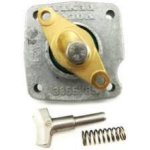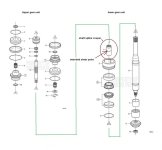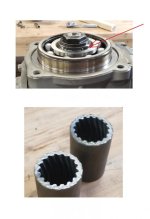painkiller
New member
Greetings. I’m new to the forum but did some reading on older posts and figured you guys might be able to help me.
Wife and I just purchased a used 2011 Cobalt 232 with a 5.7Gi and a DPS-A drive. Boat only has 50 fresh water hours on it so it’s about as new as you can get. Last evening, we went out for a cruise. Boat ran flawlessly most of the trip. Then, my wife asked me to stop so she could take a picture of the sunset. When we went to get back underway, the throttle revved up but no forward motion. The drive did not engage. I tried forward and reverse to no avail. I tried messing with the manual warm-up button. No joy. At that point I got a buddy on the phone and arranged for him to come give me a tow back to my boat lift.
Today I set out to do some diagnostics:
I reached up behind the control unit while I moved the throttle lever forward and aft. I was able to discern for sure that both the throttle and gear selector cables were moving. I worked my way aft to the transom. Again, the throttle cable worked fine, as expected, and the gear selector cable seemed to be OK too because it moved slightly when moving the throttle/gear control. Then it was time for me to jump in the water. I lowered the boat so the drive was at eye height, and removed the rear cover. I’d hoped to find the cable disconnected, which would have been an easy fix. No such luck. Cable seemed firmly attached to the bellcrank, and the bellcrank connected to the eccentric. I had my wife move the throttle/gear selector forward and aft as I watched the eccentric rotate from approx. the 1:00 position to the 5:00 position, with neutral at approximately 3:30. Then I lowered the boat some more to fully submerge the lower drive and had my wife start the engine and run through the gears. Again, the linkage assembly worked flawlessly, with no bangs, grinding, or otherwise objectionable sounds, but the props never moved. When shut down the props turn freely in both directions.
Cable is good and control unit is good. Problem seems to be inside the drive.
I’ve gone about as far as I can go with my limited knowledge of these drives. Anybody got any ideas where I go next?
Wife and I just purchased a used 2011 Cobalt 232 with a 5.7Gi and a DPS-A drive. Boat only has 50 fresh water hours on it so it’s about as new as you can get. Last evening, we went out for a cruise. Boat ran flawlessly most of the trip. Then, my wife asked me to stop so she could take a picture of the sunset. When we went to get back underway, the throttle revved up but no forward motion. The drive did not engage. I tried forward and reverse to no avail. I tried messing with the manual warm-up button. No joy. At that point I got a buddy on the phone and arranged for him to come give me a tow back to my boat lift.
Today I set out to do some diagnostics:
I reached up behind the control unit while I moved the throttle lever forward and aft. I was able to discern for sure that both the throttle and gear selector cables were moving. I worked my way aft to the transom. Again, the throttle cable worked fine, as expected, and the gear selector cable seemed to be OK too because it moved slightly when moving the throttle/gear control. Then it was time for me to jump in the water. I lowered the boat so the drive was at eye height, and removed the rear cover. I’d hoped to find the cable disconnected, which would have been an easy fix. No such luck. Cable seemed firmly attached to the bellcrank, and the bellcrank connected to the eccentric. I had my wife move the throttle/gear selector forward and aft as I watched the eccentric rotate from approx. the 1:00 position to the 5:00 position, with neutral at approximately 3:30. Then I lowered the boat some more to fully submerge the lower drive and had my wife start the engine and run through the gears. Again, the linkage assembly worked flawlessly, with no bangs, grinding, or otherwise objectionable sounds, but the props never moved. When shut down the props turn freely in both directions.
Cable is good and control unit is good. Problem seems to be inside the drive.
I’ve gone about as far as I can go with my limited knowledge of these drives. Anybody got any ideas where I go next?






